The release of photos of 9/11 in response to a Freedom of Information Act request from ABC News posed a problem for the government. When they are viewed in a sequential order, they tell a story that contradicts the official account of a "pancake collapse". In fact, the towers did not collapse: tons of concrete and a major fraction of the steel columns were converted into millions of cubic yards of very fine dust. To obfuscate the evidence, the photos were released in random order. Consider what happens when Prof. James Fetzer, the founder of Scholars for 9/11 Truth, sequences them properly.

The following images were taken from a police helicopter — the only photographers allowed in the airspace near the skyscrapers on Sept. 11, 2001:

Newly released aerial photos of the World Trade Center terror attack capture the towers’ dramatic collapse, from just after the first fiery plane strike to the apocalyptic dust clouds that spread over lower Manhattan. But the photos suggest something else was going on. This does not look like a "collapse".

The images were taken from a police helicopter—the only photographs allowed in the air space near the towers on September 11, 2001. Underwriters Laboratory had certified the steel up to 2,000°F for three to four hours. When NIST sampled 236 pieces of steel, it found 233 had not even been exposed to temperatures above 500°F—and the other three not above 1,200°F.

ABC News obtained them among 2,779 pictures released in response to a Freedom of Information Act request (FOIA). In the air for three hours, Det. Greg Semendinger took three rolls of 36 stills with his personal Minolta Maxxum 7000 camera and another 245 with his digital Olympus U-2100.

It took a year for the National Institute of Standards and Technology to respond to ABC News. NIST may not have wanted to release them, because they contradict its theory that the heat from the fires cause the towers to collapse. Since the fires were not evenly distributed, any "collapse" should have been asymmetrical, too—slow and gradual, not complete and total.
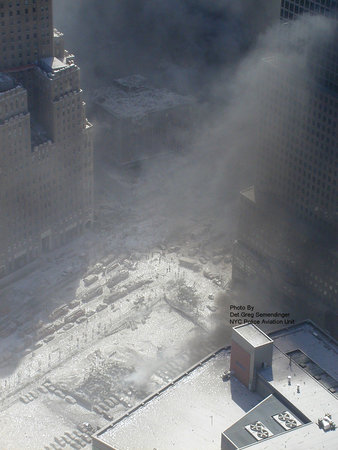
Semendinger gave his photographs to the 9/11 commission set up to investigate the attack. From there, they made their way to NIST as part of its probe of the buildings’ destruction. This one shows the fragile "bathtub" beneath the towers, which kept Hudson River water out. They remained intact only because the buildings did not collapse but were turned to dust.
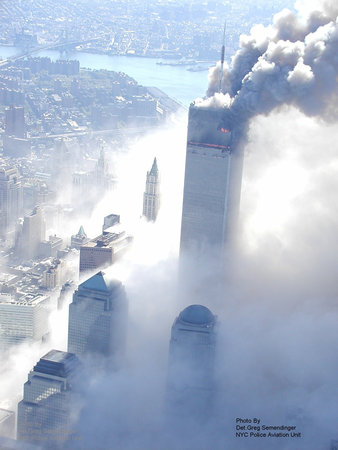
Notice that the South Tower has already turned to dust, which is enveloping lower Manhattan. The modest fires only burned for about an hour in the South Tower and an hour and a half in the North Tower—neither long enough nor hot enough to cause the steel to weaken, much less melt.
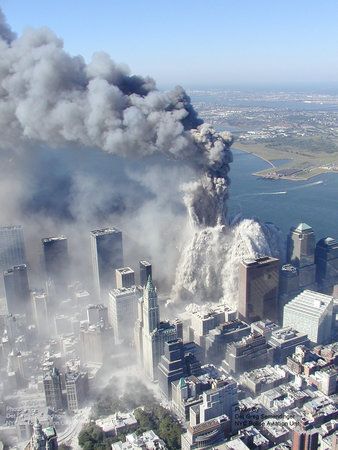
How could anyone—including NIST—have viewed the conversion of these two 500,000-ton towers into millions of cublic yards of very fine dust and concluded that they had "collapsed"? It reminds me of the old Richard Pryor joke, "Who are you going to believe—me or your lying eyes?" Ask yourself!
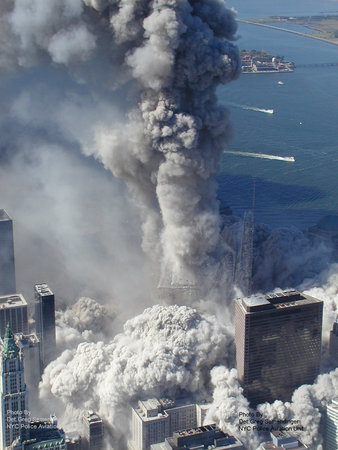
Notice the remnants of its core columns of the North Tower. Footage of the destruction of the building actually shows those remnants turning to dust—including, of course, the steel. Something quite unusual was taking place in New York City. Here you can see it happening before your very eyes—steel and concrete being converted into dust!
While CNN News described it as "smoke", what you are viewing is the remnant of the core colums of the North Tower turning to dust—which is hardly surprising, since that is happening to the entire building. That is where those millions of cubic yards of very fine dust is coming from. No wonder NIST did not want to release these photos.

And the dust cloud grew . . .

and grew . . .

and grew . . .
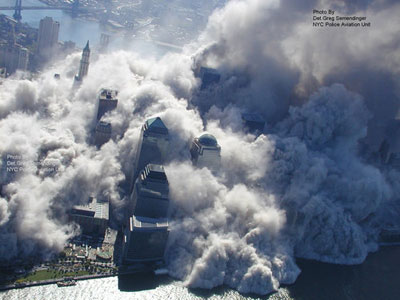
enveloping lower Manhattan . . .

and gradually blowing out to sea.

 Articles by this author
Articles by this author Send a message
Send a message
















Stay In Touch
Follow us on social networks
Subscribe to weekly newsletter